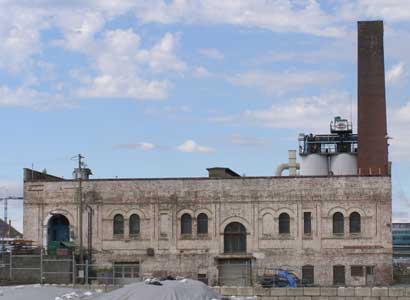Heritage Register
Burnside
2110 Store Street
The Powerhouse
Built
1892
Heritage-Designated 2010/Industrial
For: National Electric Tramway & Light Company
Architect: John Teague

ARCHITECTURE:
This large commercial brick building in heavy Romanesque style has an arched entrance at the left end of the façade with pilasters with plain moulded capitals; the façade to the right of the entrance bay is symmetrically arranged with two pairs of smaller arched windows on each side of a single, much larger arched window topped with a panel dated 1892. The basement level had a large door with a cement bracketed canopy under the large window. Because of the sloping site, the basement beyond the entrance bay is at ground level. The main storey has regularly spaced pairs of brick pilasters. Window heads and mouldings are parged, as are both ends, and a broad band of plain parging suggests a lost sheet metal cornice. A narrow moulded metal capping survives. The rear R corner has a tall square smokestack minus its original corbelling.
ORIGINAL OCCUPANTS:
Designed by John Teague, mayor and architect of City Hall, The Powerhouse was built for $15,000 to generate electricity for the tram network (502-08 Discovery St, Burnside), after an earlier plant burned. VDC reported August 8, 1892 that it was to be a “substantial structure of stone, brick and iron.” The company became Victoria Electric Railway Co in 1895 shortly before an overloaded streetcar caused the Point Ellice Bridge to collapse, on May 26, 1896. The company then became Consolidated Railway Co but soon folded. Sir Frank Barnard (1462 Rockland Av, Rockland) and R.M. Horne-Payne had formed British Columbia Electric Railway Co in 1892 and BCER took over the powerhouse. They stopped producing electricity soon after WWI, and dropped “Railway” from the name by 1951. The Powerhouse was converted to produce coal gas, until 1955. Natural gas conversion began, and much of the powerhouse was used as workshops. Part of the second storey became a gymnasium for employees. BC Hydro, which evolved out of BCE, for many years used it for its electric meter department. The powerhouse was vacant until a gas and boiler installation company, Apex Steel & Gas, moved into part of the building in 1989.
The Powerhouse was designated in 2010, as a soil remediation project continues.
ADDITIONAL INFORMATION & IMAGES:
• Burnside History
• Burnside Heritage Register
• Hallmark Heritage Society Archives
• This Old House, Victoria's Heritage Neighbourhoods,
Volume Three: Rockland, Burnside, Harris Green, Hillside-Quadra,
North Park & Oaklands

